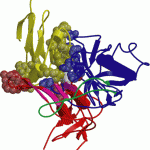There has been a plethora of newly discovered HIV neutralizing antibodies (NaB) made over the past 5 years. One such NaB is known as VRC01 and recognizes the CD4 binding site on HIV-1. In the recent edition of Science Translational Medicine, Lynch and multiple colleagues used VRC01 in ART-treated and untreated HIV-1–infected subjects to assess the ability of the NaB to reduce viral reservoirs and load in vivo.
The first part of the study focused on 6 ART-treated individuals who had undetectable plasma viral loads. Four weeks after receiving two infusions of the VRC01 antibody, no reduction in the peripheral blood viral reservoir was observed. In the second part of the study, VRC01 was given to ART-untreated individuals and three quarters of the patients (6 of 8) showed a 1.1-1.8 log10 reduction in plasma viral load after only one dose. Most exciting was the finding that two of the ART untreated participants who had plasma viral loads <1000 copies demonstrated undetectable virus almost 3 weeks after the initial dose and until the VRC01 levels declined. The authors stated that “among the remaining four subjects with baseline virus loads between 3000 and 30,000 copies, viremia was only partially suppressed by mAb infusion…”.
The authors also observed that the host virus which was not suppressed by the VRC01 infusion was insensitive to the in vitro neutralization effects. This would support the notion that in some patients there was selection pressure for the outgrowth of less neutralization-sensitive viruses.
The authors conclude: “a single infusion of mAb VRC01 significantly decreased plasma viremia and preferentially suppressed neutralization-sensitive virus strains.” This is the first chink of light for successful passive immunizations against HIV and this may herald the way for inclusion of neutralizing antibodies to be added to drug regimens and prevention strategies.
